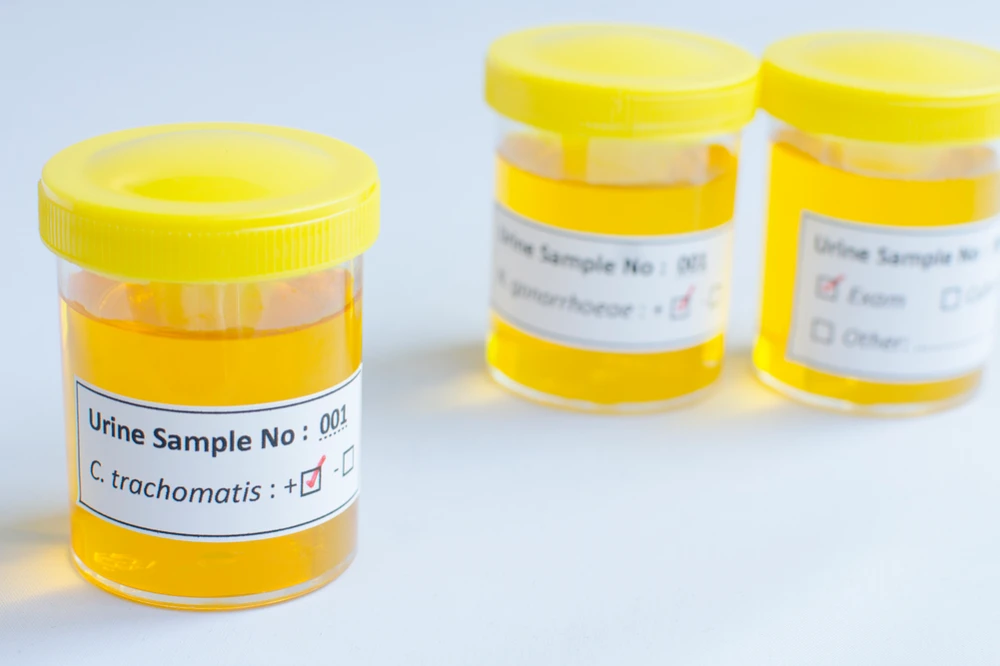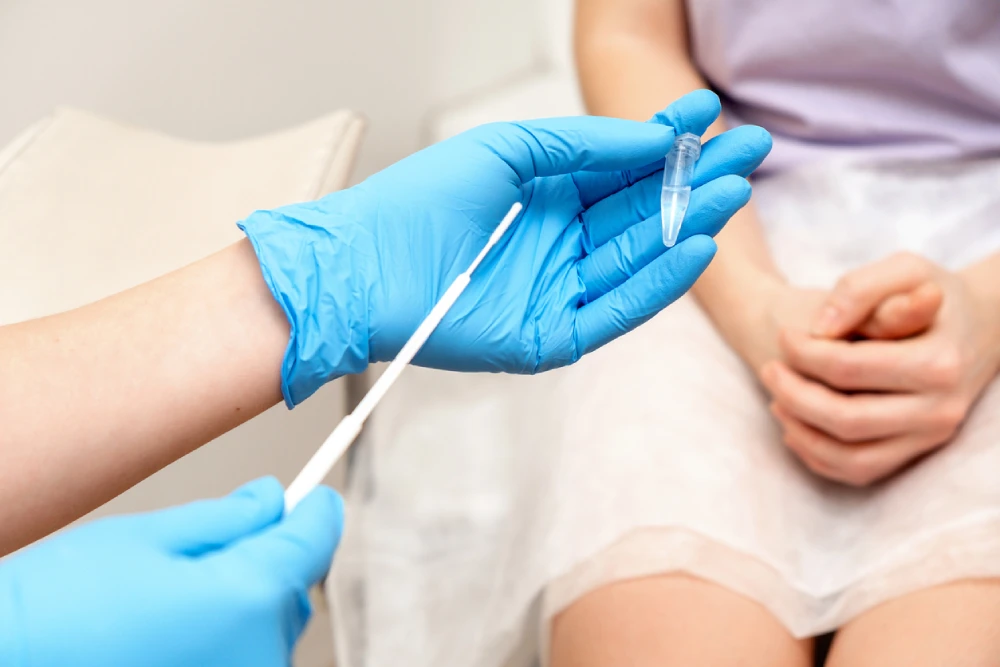Chlamydia is one of the most common sexually transmitted infections (STIs) in the country, with the Government of Canada stating there were more than 100,000 cases reported in 2021. Yet many people never realize they have it. Chlamydia symptoms are often mild or even absent, and can silently damage reproductive health if left untreated.
We believe knowledge is the first step toward protecting your sexual health.
In this article, you will learn how to recognize possible signs of infection, when to get tested, what the most effective treatments are, and how to prevent future infections.
Whether you are seeking information for yourself, a partner, or a loved one, our goal is to help you take control of your health with clear, trustworthy advice and accessible care options.
Chlamydia Explained – The Silent Infection Affecting Thousands
Chlamydia is an infection caused by the bacterium Chlamydia trachomatis. It spreads through unprotected vaginal, anal, or oral sex with an infected partner. It can also be passed from a pregnant parent to their baby during childbirth, which is why early testing and treatment are so important.
This infection affects people of all genders and sexual orientations, though the highest rates are seen in people under 30, reflecting both increased risk and more frequent testing in this age group.
Chlamydia is often called the “silent disease” because it can easily go unnoticed, with many never experiencing symptoms. In fact, the Government of Canada estimates that over 50 percent of infected males and 70 percent of infected females show no symptoms and do not know they are infected.
Without testing, many continue to unknowingly pass it to others, and their own health may be at risk due to untreated complications.
This lack of symptoms makes chlamydia a public health challenge. Without awareness and screening, infections can remain hidden for months or even years, causing serious reproductive health problems.
Recognizing the risk and making regular STI testing part of your routine care is one of the most effective ways to protect yourself and your partners.

Spotting Chlamydia Symptoms – Differences by Sex and Site of Infection
While chlamydia symptoms may not always develop, when they do, they typically appear within 1 to 3 weeks. Because of this delay and the high chance of being symptom-free, testing is the only way to confirm a chlamydia infection.
When symptoms do occur, they often depend on the site of infection and can vary from person to person, but there is significant overlap between people with a cervix and those with a penis.
Genital Symptoms
Whether you have a cervix or a penis, chlamydia can cause:
- Abnormal discharge from the vagina or penis, which may have an unusual colour or smell
- Pain or burning during urination
- Vaginal pain during penetrative sex
- Bleeding between periods or after sexual intercourse
- Lower abdominal or pelvic pain
- Testicular pain or swelling
Rectal, Throat, and Eye Infections
Due to how chlamydia is transferred, it can also infect other areas of the body, such as the throat, rectum or eyes.
- Rectal infections may cause discharge, pain, bleeding, or itching, but can also be symptom-free.
- Pharyngeal (throat) infections are often asymptomatic but may cause a mild sore throat.
- Ocular infections (in adults or newborns) can cause redness, swelling, and discharge in the eye.
Chlamydia Complications if Untreated: Why Early Care Is Critical
When chlamydia goes undetected and untreated, it can lead to serious and sometimes permanent health problems. The infection may quietly cause damage over time, which is why early testing and treatment are essential.
While men and women face individual complications, according to the Cleveland Clinic, one complication that can affect anyone, regardless of sex, is reactive arthritis. This can cause joint inflammation, eye irritation, and urinary discomfort.
Complications of Chlamydia in Women and People with a Cervix
For those with a cervix, untreated chlamydia can spread to the uterus and fallopian tubes, causing pelvic inflammatory disease (PID). PID can result in:
- Chronic pelvic pain
- Blocked fallopian tubes, which may cause infertility
- An increased risk of ectopic pregnancy, where a fertilized egg implants outside the uterus, which is a potentially life-threatening condition
- Infertility
Complications of Chlamydia in Men and People with a Penis
For men, untreated chlamydia can lead to epididymitis, an inflammation of the tube that stores and carries sperm. This can cause testicular pain, swelling, and, in rare cases, reduced fertility.
Pregnancy and Newborn Risks
If a pregnant person has chlamydia, it can cause complications such as premature rupture of membranes or preterm delivery.
Babies exposed during birth are also at risk of contracting the infection and may develop neonatal conjunctivitis (eye infection) or pneumonia, both of which require prompt medical care.
Reinfection and Cumulative Damage
Having chlamydia once does not protect you from getting it again. Each reinfection increases the risk of long-term complications. This is why completing treatment, taking preventative steps, and retesting when recommended are critical steps for protecting your health.
Who Should Get Tested for Chlamydia (Screening & Risk-Based Testing in Canada)
Because chlamydia is so often symptom-free, regular testing is one of the most effective ways to prevent complications and stop the spread of the infection.
Routine Screening Recommendations For Chlamydia
The Canadian Task Force on Preventive Health Care recommends annual opportunistic screening for people under the age of 30 who are sexually active and are not part of a high-risk group. This can be done during a routine visit to a healthcare provider, even if you are not experiencing symptoms.
Risk-Based Testing
If you are at higher risk, more frequent testing may be advised. Testing is recommended if you:
- Have a new sexual partner or have had more than one partner in the past year
- Have a partner who has tested positive for chlamydia or another STI
- Engage in sex without condoms
- Participate in group sex or have anonymous sexual partners
- Have a history of STIs
- Are pregnant, as part of prenatal care
After Exposure
If you learn that a sexual partner has been diagnosed with chlamydia, you should get tested as soon as possible, even if you have no symptoms.
It is also important to notify any partners you have had in the last 60 days so they can get tested and treated as well.
Retesting After Treatment
Reinfection is common, especially within the first few months after treatment. Retesting is recommended three months after completing treatment to confirm you are still clear of the infection and to catch any reinfection early.
Chlamydia Diagnosis – What Modern Tests Are Used in Canada
Getting tested for chlamydia is straightforward, accurate, and widely available across Canada. Modern testing methods are highly sensitive, meaning they can detect infections even when no symptoms are present.
Nucleic Acid Amplification Test (NAAT)
The NAAT is the most accurate method for diagnosing chlamydia. It works by detecting the genetic material of Chlamydia trachomatis in a sample. NAAT can be done using:
- Urine samples for people with a penis
- Swab samples from the cervix, vagina, urethra, rectum, or throat, depending on sexual practices and potential exposure
Your healthcare provider will determine which type of sample is most appropriate for you.
Self-Collection Options
In some regions, self-collected vaginal swabs or urine samples are available through sexual health clinics, public health programs, or community initiatives.
Research shows that self-collected samples are just as accurate as those collected by a clinician, and they can make testing more comfortable and accessible.
Where to Get Tested
You can get tested at:
- Family doctor offices
- Public health or sexual health clinics
- Community outreach programs and mobile testing units in certain areas
Waiting for Results
NAAT results are usually available within a few days, although timing may vary by location. While waiting for results, it is important to avoid sexual activity to prevent potentially passing the infection to others.
First-Line Chlamydia Treatment in Canada: Evidence-Based Antibiotics
Chlamydia is curable with the right antibiotics. In Canada, the three most commonly used medications are doxycycline, azithromycin, and amoxicillin. Each has specific situations where it may be the best choice, depending on your health needs and the circumstances of the infection.
- Doxycycline: Preferred option for most uncomplicated genital, rectal, and throat infections because of its high effectiveness. Not recommended during pregnancy or for people allergic to tetracyclines.
- Azithromycin: Chosen for pregnancy and breastfeeding due to its safety profile. Also used when a shorter treatment course is needed or when adherence to a multi-day regimen may be difficult.
- Amoxicillin: A penicillin-based antibiotic that is used as an alternative for those who cannot take doxycycline, particularly during pregnancy, and in certain cases where azithromycin is not suitable.
Special situations requiring tailored treatment:
- LGV (Lymphogranuloma Venereum): Requires longer treatment, often 21 days of doxycycline, as the infection involves deeper tissues.
- Newborns: Azithromycin is used for chlamydia-related eye infections or pneumonia in infants exposed during birth.
- Persistent or Complicated Infections: May require a different antibiotic or extended treatment duration based on symptoms and follow-up testing.
Finishing the prescribed course is essential. Stopping early or missing doses can lead to treatment failure and continued infection, even if symptoms improve quickly.
Chlamydia Treatment Follow-Up: Test-of-Cure, Retesting, and Avoiding Reinfection
Treatment is highly effective when taken correctly, but follow-up care is essential to ensure the infection is fully cleared and to protect against reinfection.
Completing this step protects not only your health but also the health of your current and future partners.
When a Test-of-Cure Is Recommended
A test-of-cure is a repeat test performed after treatment to confirm that the infection is gone. While it is not required for most people, it is recommended if:
- You are pregnant
- Symptoms persist after treatment
- There is concern that you may not have completed the antibiotic course
- Your healthcare provider suspects antibiotic resistance or reinfection
Test-of-cure is usually done about 4 weeks after finishing antibiotics.
Retesting for Reinfection
Even if your test-of-cure is clear, reinfection can occur if your partner was not treated or if you are exposed to the bacteria again. Standard public health guidelines recommend retesting 3 months after treatment to catch any new infections early.
Avoiding Sexual Activity Until Treatment Is Complete
It is important to avoid sexual contact until:
- You and your partner(s) have finished treatment
- Any follow-up testing (if recommended) confirms the infection has cleared
Resuming sexual activity too soon can lead to passing the infection back and forth.
Partner Notification
If you test positive for chlamydia, all sexual partners from the last 60 days should be notified, tested, and treated.
Many public health units offer partner notification services that can help keep your identity confidential.

Chlamydia Prevention & Risk Reduction in Canada
While chlamydia is common, there are reliable ways to reduce your risk and protect both your own health and the health of your partners.
Prevention is especially important because the infection often has no symptoms, meaning it can be spread without anyone realizing.
Use Condoms Correctly and Consistently
Condoms provide strong protection against chlamydia when used the right way from start to finish during oral, vaginal and anal intercourse.
Both internal (female) and external (male) condoms are effective, and they should be used every time, even if you or your partner seems healthy.
This also applies to the use of sex toys. If you are sharing toys, always wash them and use a condom during use.
Limit the Number of Sexual Partners
Reducing your number of sexual partners lowers the chance of exposure. If you are in a mutually monogamous relationship and both partners have tested negative for STIs, your risk is significantly reduced.
Get Tested Regularly
Routine STI screening is key, particularly if you:
- Have a new sexual partner
- Have multiple partners
- Share sex toys
- Do not always use condoms
- Are under 30 and sexually active
- Are pregnant or planning to become pregnant
Regular testing helps identify and treat infections before they cause complications or spread to others.
Seek Prompt Treatment
If you test positive for chlamydia, start treatment right away and encourage partners to do the same.
Avoid sexual contact until treatment is complete and, if recommended, follow-up testing confirms the infection has cleared.
Use Digital Tools for Retesting Reminders
Some sexual health clinics offer digital reminders to help you schedule follow-up testing. This can be especially helpful in preventing reinfection.
Education, testing, and open communication with partners are the foundation of chlamydia prevention. Taking proactive steps today can protect your health in the long term.
Chlamydia Risk Factors
While anyone who is sexually active can get chlamydia, certain factors increase the likelihood of infection.
If one or more of these apply to you, regular testing and preventive measures are especially important.
- Adolescents and young adults: People under 30 often are at a higher risk. Contributing factors can include less access to confidential healthcare, lower screening rates, and limited experience negotiating condom use.
- Multiple sexual partners: Having more than two partners in a year increases your risk of exposure, especially if barrier protection is not used consistently.
- History of STIs: Previous chlamydia or other STI infections raise the risk of reinfection, particularly within the first few months after treatment.
- Engagement in specific sexual practices: Participating in group sex or anal sex without barrier protection increases the chance of transmission.
- Other health conditions: People with HIV or other STIs are more vulnerable to infection due to reduced immune defences and existing inflammation.
If you fall into one or more of these categories, more frequent testing can help catch infections early and prevent complications.
Accessing Chlamydia Care in Canada: Clinics, Coverage, and Pharmacy Support
Getting tested and treated for chlamydia is straightforward in Canada, and many services are low-cost or free. Knowing your options can make it easier to take the first step toward protecting your sexual health.
Where to Access Care
You can get confidential testing and treatment through:
- Family doctors: Can provide testing, prescriptions, and follow-up care.
- Public health units: Offer free and confidential STI testing, treatment, and partner notification services.
- Sexual health clinics: Provide walk-in or appointment-based services, often at no cost.
- Community pharmacies: Some pharmacies, including many PharmaChoice locations, offer testing referrals and treatment support in partnership with local healthcare providers.
Cost and Coverage Considerations
Many public health clinics and sexual health programs offer free testing and medication.
If medication is not provided on-site, provincial drug plans or private insurance may cover the cost.
Some pharmacies can bill directly to your insurance provider, reducing out-of-pocket expenses.
How PharmaChoice Pharmacists Can Help
We are here to support your sexual health needs with:
- Confidential consultations and symptom guidance
- Referrals for testing at clinics or healthcare providers
- Support to help you complete your full antibiotic course
- Advice on safer sex practices and prevention strategies
To further support your prevention strategies and safe-sex habits, many PharmaChoice pharmacies carry:
- Educational materials on STIs
- Home care supplies for symptom relief
- Condoms, lubricants, and other safer sex products
Common Chlamydia Questions
How long does it take for chlamydia to go away?
With the right antibiotics, chlamydia usually clears within 7 days. You should avoid sexual activity until you and your partner(s) have completed treatment and, if recommended, follow-up testing confirms the infection is gone.
How serious is chlamydia?
Chlamydia is treatable, but untreated infections can cause serious health issues such as pelvic inflammatory disease, infertility, ectopic pregnancy, or testicular inflammation. Early testing and treatment prevent these complications.
How to tell if you’ve had chlamydia?
The only way to know for sure is through testing. Many people have no symptoms, so you may have had it without realizing. Routine screening is the best way to detect it.
What does chlamydia first feel like?
If symptoms appear, they may include unusual genital discharge, pain or burning during urination, pelvic or abdominal discomfort, or testicular pain. However, most infections cause no symptoms at all.
Find Support At Your Local PharmaChoice Pharmacy
At PharmaChoice, we are committed to helping you take control of your sexual health.
Talk to your local PharmaChoice pharmacist today for confidential advice, testing support, and trusted treatment options to help you stay healthy and informed.





